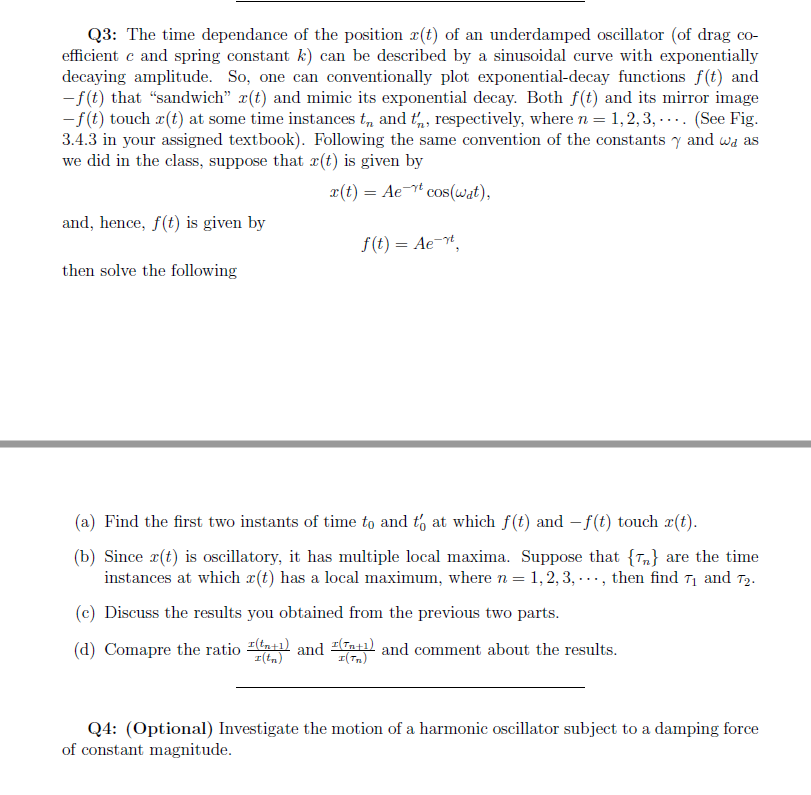Q3: The time dependance of the position r(t) of an underdamped oscillator (of drag co- efficient c and spring constant k) can be described by a sinusoidal curve with exponentially decaying amplitude. So, one can conventionally plot exponential-decay functions f(t) and -f(t) that "sandwich" æ(t) and mimic its exponential decay. Both f(t) and its mirror image -f(t) touch r(t) at some time instances t, and t,, respectively, where n = 1, 2, 3, - ... (See Fig. 3.4.3 in your assigned textbook). Following the same convention of the constants y and wa as we did in the class, suppose that r(t) is given by x(t) = Aet cos(wat), and, hence, f(t) is given by f(t) = Ae-, then solve the following (a) Find the first two instants of time to and t, at which f (t) and – f(t) touch x(t). (b) Since r(t) is oscillatory, it has multiple local maxima. Suppose that {T,} are the time instances at which x(t) has a local maximum, where n = 1, 2, 3, -.., then find 71 and T2. (c) Discuss the results you obtained from the previous two parts. (d) Comapre the ratio tal and nl and comment about the results. I(tm) 1(Tn) Q4: (Optional) Investigate the motion of a harmonic oscillator subject to a damping force of constant magnitude.
Q3: The time dependance of the position r(t) of an underdamped oscillator (of drag co- efficient c and spring constant k) can be described by a sinusoidal curve with exponentially decaying amplitude. So, one can conventionally plot exponential-decay functions f(t) and -f(t) that "sandwich" æ(t) and mimic its exponential decay. Both f(t) and its mirror image -f(t) touch r(t) at some time instances t, and t,, respectively, where n = 1, 2, 3, - ... (See Fig. 3.4.3 in your assigned textbook). Following the same convention of the constants y and wa as we did in the class, suppose that r(t) is given by x(t) = Aet cos(wat), and, hence, f(t) is given by f(t) = Ae-, then solve the following (a) Find the first two instants of time to and t, at which f (t) and – f(t) touch x(t). (b) Since r(t) is oscillatory, it has multiple local maxima. Suppose that {T,} are the time instances at which x(t) has a local maximum, where n = 1, 2, 3, -.., then find 71 and T2. (c) Discuss the results you obtained from the previous two parts. (d) Comapre the ratio tal and nl and comment about the results. I(tm) 1(Tn) Q4: (Optional) Investigate the motion of a harmonic oscillator subject to a damping force of constant magnitude.
Classical Dynamics of Particles and Systems
5th Edition
ISBN:9780534408961
Author:Stephen T. Thornton, Jerry B. Marion
Publisher:Stephen T. Thornton, Jerry B. Marion
Chapter7: Hamilton's Principle-lagrangian And Hamiltonian Dynamics
Section: Chapter Questions
Problem 7.21P
Related questions
Question

Transcribed Image Text:Q3: The time dependance of the position 2(t) of an underdamped oscillator (of drag co-
efficient c and spring constant k) can be described by a sinusoidal curve with exponentially
decaying amplitude. So, one can conventionally plot exponential-decay functions f(t) and
-f(t) that "sandwich" x(t) and mimic its exponential decay. Both f(t) and its mirror image
-f(t) touch r(t) at some time instances t„, and t,, respectively, where n = 1,2, 3, -... (See Fig.
3.4.3 in your assigned textbook). Following the same convention of the constants y and wa as
we did in the class, suppose that #(t) is given by
x(t) = Ae cos(wat),
and, hence, f(t) is given by
f(t) = Ae-.
then solve the following
(a) Find the first two instants of time to and t, at which f(t) and - f(t) touch x(t).
(b) Since r(t) is oscillatory, it has multiple local maxima. Suppose that {Tn} are the time
instances at which x(t) has a local maximum, where n = 1, 2, 3, -.., then find T1 and T2.
(c) Discuss the results you obtained from the previous two parts.
(d) Comapre the ratio tatl and (nt1l and comment about the results.
I(tn)
I(Tn)
Q4: (Optional) Investigate the motion of a harmonic oscillator subject to a damping force
of constant magnitude.
Expert Solution
This question has been solved!
Explore an expertly crafted, step-by-step solution for a thorough understanding of key concepts.
Step by step
Solved in 3 steps with 3 images

Recommended textbooks for you

Classical Dynamics of Particles and Systems
Physics
ISBN:
9780534408961
Author:
Stephen T. Thornton, Jerry B. Marion
Publisher:
Cengage Learning

Physics for Scientists and Engineers: Foundations…
Physics
ISBN:
9781133939146
Author:
Katz, Debora M.
Publisher:
Cengage Learning

Modern Physics
Physics
ISBN:
9781111794378
Author:
Raymond A. Serway, Clement J. Moses, Curt A. Moyer
Publisher:
Cengage Learning

Classical Dynamics of Particles and Systems
Physics
ISBN:
9780534408961
Author:
Stephen T. Thornton, Jerry B. Marion
Publisher:
Cengage Learning

Physics for Scientists and Engineers: Foundations…
Physics
ISBN:
9781133939146
Author:
Katz, Debora M.
Publisher:
Cengage Learning

Modern Physics
Physics
ISBN:
9781111794378
Author:
Raymond A. Serway, Clement J. Moses, Curt A. Moyer
Publisher:
Cengage Learning